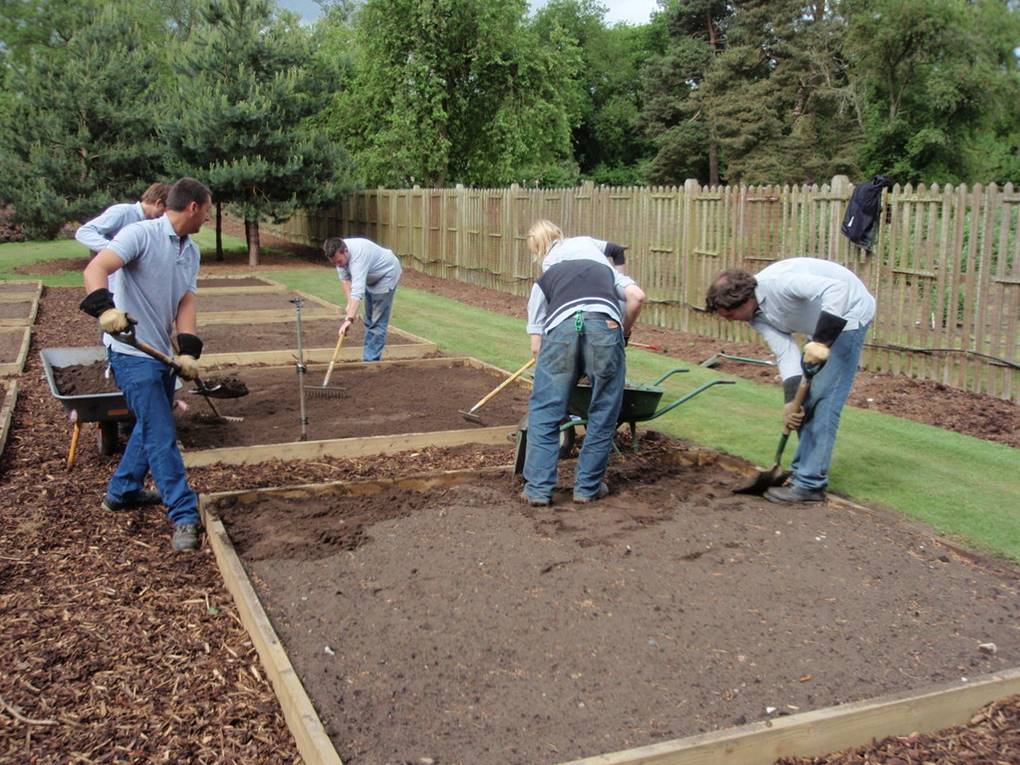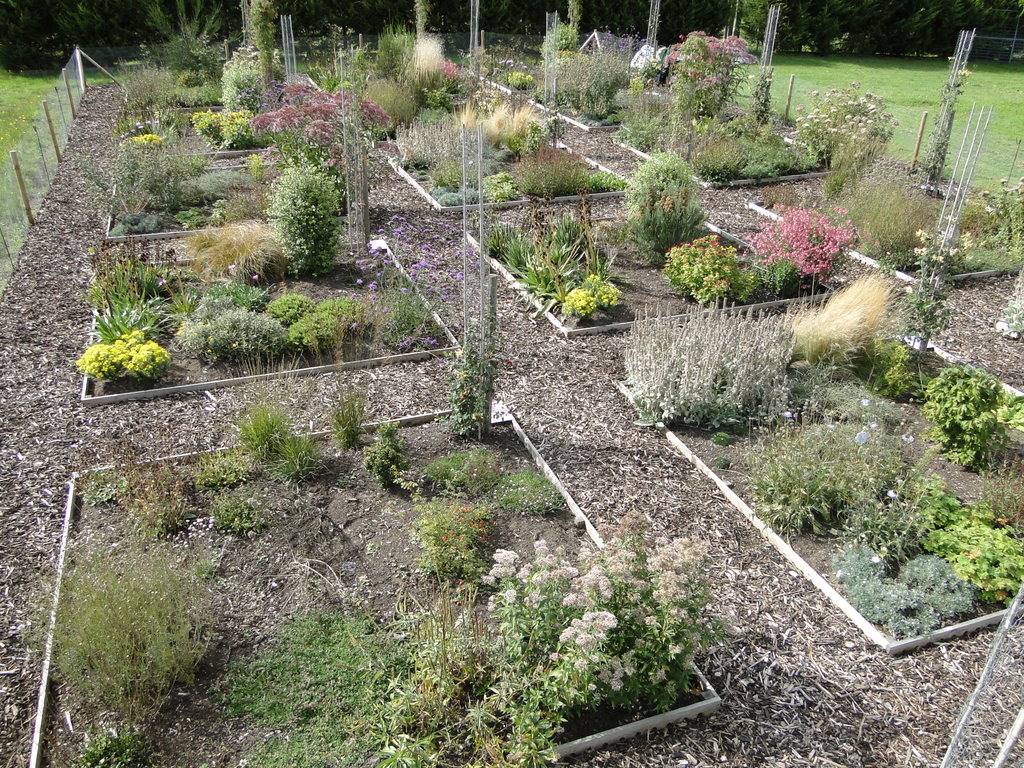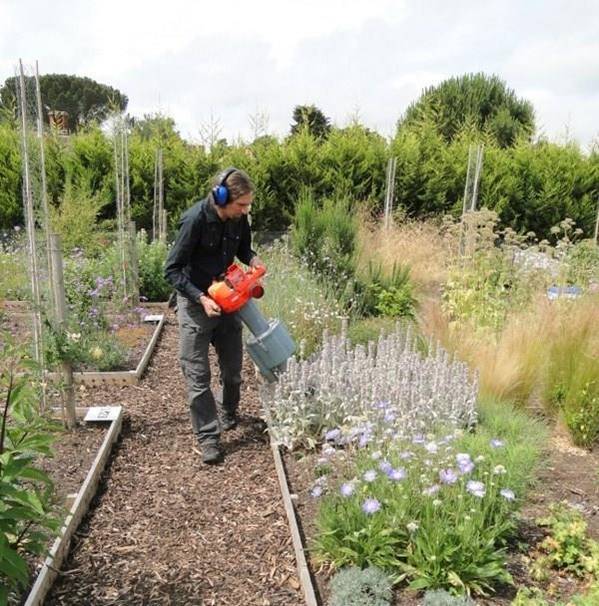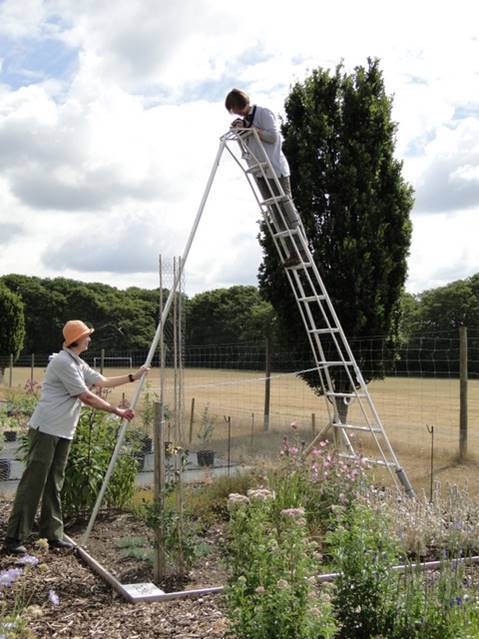- Home
- Garden Science
- Garden Ecology
- Plants for Bugs Project
The Plants for Bugs Project
Project details
Title: Plants for Bugs: A project investigating invertebrate abundance and diversity in assemblages of native and non-native garden plant species
Field duration: 2009 to 2013, data processing still continuing
Location: RHS Gardens Wisley, Surrey
Project Manager: Helen Bostock
Assistant Project Manager: Dr Andrew Salisbury
Project background and aims
Studies into biodiversity in urban gardens (BUGS Projects) at the University of Sheffield demonstrated that garden habitats were able to support a rich diversity of plant and animal species. However, despite 70% of plants in the average UK garden being non-native (i.e. of origin outside Britain), the dominant advice to gardeners wishing to garden with wildlife in mind has been to plant British native plants. This suggested that the role of native and non-native plants in supporting garden wildlilfe was unclear and would benefit from further research.
In April 2007 the Research Working Group of the Wildlife Gardening Forum approached the Royal Horticultural Society with a research proposal. This developed into the study known as the ‘Plants for Bugs’ project, the purpose of which was to compare British native and non-native garden plantings for invertebrates. "Bugs" (more formally invertebrates) cover thousands of species and many different functional groups, such as predators, herbivores, detritivores and pollinators. It was considered they would provide a good reflection of the ecological health of a plot planted with a selection of garden plants, and they are much more diverse and easier to study than for example birds or mammals.
The aim of the Plants for Bugs project is to provide evidence-based advice for the wildlife gardener on the use of native and non-native plants. For scientist readers, the null hypothesis being tested was that "there is no difference in invertebrate abundance associated with assemblages (artificial communities) of UK native and non-native garden plants". More simply, the essential question posed by the project was “Do bugs care about the geographical origin of plants in gardens?"
It must be emphasised that this project was specifically designed to test the response of inveterbrates to typical garden bed planting. The size and area were comparable to real garden beds, and both the number of species and the density of planting, were chosen to be a realistic model of normal garden practice. The species planted were all "garden-worthy", and all the groups of plants included typical garden forms such as climbers, shrubs, grasses and ferns.
Project set-up
In 2009 thirty-six timber-edged 3×3m plots were planted, equally divided over two sites at RHS Garden Wisley, one at Howard’s Field (open to Garden visitors) and the other at Deer’s Farm (closed to the public). Each plot was separated by a 1m-wide woodchip guard-row.


P4B plots being laid out at RHS Wisley, 2009 Plots shortly after planting
A third of the plots were planted with British native plants (referred to as the ‘native’ treatment), a third with closely related species from the Northern Hemisphere (referred to as the ‘near-native’ treatment) and the remaining third with species from the Southern Hemisphere (referred to as the ‘exotic’ treatment). The layout followed a randomised split-plot design with a total of nine planting variations (native A, B and C; near-native A, B and C; and exotic A, B and C). A minimum of 14 (from a total of 24) plant species was selected for each plot to minimize any effects of species choice on the results.
The plots were kept as garden-like as possible; hand weed control was carried out to prevent flowering and competition with the plant assemblages, and plants were watered, cut back or staked where required. No pesticides were used on the plots. For a fuller account of the project set up, including a download list of the plants used, visit this web page.
Project sampling and data collection
Invertebrates from native, near-native and exotic plots were recorded from the ground (using pitfall and gastropod traps), the foliage (using a Vortis suction sampler) and flying insects were recorded by visual observations). Soil fauna was also investigated in a PhD in association with the University of Roehampton. Specimens were identified to species where possible, or at least guild (a group of species that utilizes resources in a similar way, e.g. predator, generalist or herbivore). By the end of December 2013 approximatelyover 80 000 invertebrates had been counted and more than 300 species identified. This includes more than 8 9 000 flying insects visitors (pollinators), 47 species and nearly 2000 specimens of ground beetle (Carabidae) and more than 30 species of spider.
Other data recorded included plant density and canopy cover (estimating vegetation volume), soil moisture, numbers of flowers, and nectar volume and composition.



Left: Andy Salisbury sampling insects with a Vortis vacuum sampler. Centre: Helen Bostock on the ladder measuring canopy cover using a camera. Right: sorting the Vortis samples.
Project results and interpretation
By the end of 2017 two scientific papers had been produced and interpreted: on the flying insect visitors (pollinators) and the invertebrates inhabiting the plants. The key messages are summarised below.
Pollinators:
Findings from the pollinating insects were published in the Journal of Applied Ecology in 2015 .
Full interpretation of the data can be found in the RHS project interpretation bulletin 1.
In summary the key messages for planting for pollinators in gardens are:
• The best strategy for gardeners wanting to support pollinating insects in gardens is to plant a mix of flowering plants from different countries and regions.
• Emphasis should be given to plants native to the UK and the northern hemisphere, though exotic plants from the southern hemisphere can be used to extend the season (there are a greater proportion of exotic plants flowering later in the season compared to UK native and northern hemisphere plants) and provide nectar and pollen for some specific pollinators.
• Regardless of plant origin (native or non-native), the more flowers a garden can offer throughout the year, the greater the number of bees, hoverflies and other pollinating insects it will attract and support.
Invertebrates on the plants:
The second scientific paper from the project reports on the abundance of invertebrates that were found on the plants, including those feeding on living plant material, on decomposing organic matter, and all other invertebrates, excluding pollinators. It was published in Biodiversity and Conservation in July 2017
Full interpretation of the data can be found in the RHS project interpretation bulletin 2
The key messages for gardeners wishing to provide habitat for invertebrates were
• To plant a predominance of plants native to the UK.
• Planting schemes that are based on plants originating from the Northern Hemisphere (near-natives) may support only marginally fewer (less than 10%) invertebrates in some functional groups (including herbivores and some predators) than UK native plant schemes. Plant schemes based on Southern Hemisphere (exotic) plants will still support a good number of invertebrates, albeit around 20% fewer than plants from the UK.
• Regardless of plant origin, the more densely a planting scheme is planted or allowed to grow, the more invertebrates of all kinds (herbivores, predators, detritivores and omnivores) it will support.
Soil surface invertebrates
The third paper of the series was published in November 2019 and described the findings of studies on the invertebrates using the soils surface - beetles, spiders, woodlice and millepedes among many others. There is an excellent resume available here. The key findings included:
• Overall, the denser the vegetation, the higher the ground-active invertebrate abundance regardless of plant origin. A notable exception is ground-active spiders, which were found in greater numbers among sparser plantings
• The best strategy for gardeners wanting to support ground-active invertebrates in gardens is to plant densely with more native and near-native plants than exotic plants.
• Planting schemes based on exotic plants may support relatively more ground-active invertebrates in winter than British native or near-native planting schemes. This is possibly related to the higher proportion of evergreens available in hardy exotic plantings
• Planting schemes based on native plants may support a greater abundance of ground-active herbivores than other planting schemes, but ground-active detritivores show no preference for plant origin.
• Species diversity appears to be reflected by invertebrate abundance: as invertebrate abundance increases so does the diversity of species.
Web links:
RHS Plants for Bugs information pages; https://www.rhs.org.uk/science/conservation-biodiversity/plants-for-bugs/plants-for-bugs-results
RHS Plants for Bugs results; https://www.rhs.org.uk/science/conservation-biodiversity/plants-for-bugs/plants-for-bugs-results
Plants for Bugs blog; http://mygarden.rhs.org.uk/blogs/science__advice/default.aspx
Salisbury, A., Armitage, J., Bostock, H., Perry, J., Tatchell, M., Thompson, K. (2015). Enhancing gardens as habitats for flower-visiting aerial insects (pollinators): should we plant native or exotic species? Journal of Applied Ecology 52:1156-1164.
Salisbury, A., Al-Beidh, S., Armitage, J., Bird, S. , Bostock, H., Platoni, A., Tatchell, M, Thompson, K. and Perry, J. (2017). Enhancing gardens as habitats for plant-associated invertebrates: should we plant native or exotic species? Biodiversity and Conservation
Salisbury, A., Al-Beidh, S., Armitage, J., Bird, S., Bostock, H., Platoni, A., Tatchell, M., Thompson, K. and Perry, J. (2019). Enhancing gardens as habitats for soil surface-active invertebrates: should we plant native or exotic species? Biodiversity and Conservation. (https://bit.ly/2sinFDA)
See also:
Page written by Helen Bostock and Andrew Salisbury reviewed and compiled by Steve Head
The Plants for Bugs Project
Project details
Title: Plants for Bugs: A project investigating invertebrate abundance and diversity in assemblages of native and non-native garden plant species
Field duration: 2009 to 2013, data processing still continuing
Location: RHS Gardens Wisley, Surrey
Project Manager: Helen Bostock
Assistant Project Manager: Dr Andrew Salisbury
Project background and aims
Studies into biodiversity in urban gardens (BUGS Projects) at the University of Sheffield demonstrated that garden habitats were able to support a rich diversity of plant and animal species. However, despite 70% of plants in the average UK garden being non-native (i.e. of origin outside Britain), the dominant advice to gardeners wishing to garden with wildlife in mind has been to plant British native plants. This suggested that the role of native and non-native plants in supporting garden wildlilfe was unclear and would benefit from further research.
In April 2007 the Research Working Group of the Wildlife Gardening Forum approached the Royal Horticultural Society with a research proposal. This developed into the study known as the ‘Plants for Bugs’ project, the purpose of which was to compare British native and non-native garden plantings for invertebrates. "Bugs" (more formally invertebrates) cover thousands of species and many different functional groups, such as predators, herbivores, detritivores and pollinators. It was considered they would provide a good reflection of the ecological health of a plot planted with a selection of garden plants, and they are much more diverse and easier to study than for example birds or mammals.
The aim of the Plants for Bugs project is to provide evidence-based advice for the wildlife gardener on the use of native and non-native plants. For scientist readers, the null hypothesis being tested was that "there is no difference in invertebrate abundance associated with assemblages (artificial communities) of UK native and non-native garden plants". More simply, the essential question posed by the project was “Do bugs care about the geographical origin of plants in gardens?"
It must be emphasised that this project was specifically designed to test the response of inveterbrates to typical garden bed planting. The size and area were comparable to real garden beds, and both the number of species and the density of planting, were chosen to be a realistic model of normal garden practice. The species planted were all "garden-worthy", and all the groups of plants included typical garden forms such as climbers, shrubs, grasses and ferns.
Project set-up
In 2009 thirty-six timber-edged 3×3m plots were planted, equally divided over two sites at RHS Garden Wisley, one at Howard’s Field (open to Garden visitors) and the other at Deer’s Farm (closed to the public). Each plot was separated by a 1m-wide woodchip guard-row.


P4B plots being laid out at RHS Wisley, 2009 Plots shortly after planting
A third of the plots were planted with British native plants (referred to as the ‘native’ treatment), a third with closely related species from the Northern Hemisphere (referred to as the ‘near-native’ treatment) and the remaining third with species from the Southern Hemisphere (referred to as the ‘exotic’ treatment). The layout followed a randomised split-plot design with a total of nine planting variations (native A, B and C; near-native A, B and C; and exotic A, B and C). A minimum of 14 (from a total of 24) plant species was selected for each plot to minimize any effects of species choice on the results.
The plots were kept as garden-like as possible; hand weed control was carried out to prevent flowering and competition with the plant assemblages, and plants were watered, cut back or staked where required. No pesticides were used on the plots. For a fuller account of the project set up, including a download list of the plants used, visit this web page.
Project sampling and data collection
Invertebrates from native, near-native and exotic plots were recorded from the ground (using pitfall and gastropod traps), the foliage (using a Vortis suction sampler) and flying insects were recorded by visual observations). Soil fauna was also investigated in a PhD in association with the University of Roehampton. Specimens were identified to species where possible, or at least guild (a group of species that utilizes resources in a similar way, e.g. predator, generalist or herbivore). By the end of December 2013 approximatelyover 80 000 invertebrates had been counted and more than 300 species identified. This includes more than 8 9 000 flying insects visitors (pollinators), 47 species and nearly 2000 specimens of ground beetle (Carabidae) and more than 30 species of spider.
Other data recorded included plant density and canopy cover (estimating vegetation volume), soil moisture, numbers of flowers, and nectar volume and composition.



Left: Andy Salisbury sampling insects with a Vortis vacuum sampler. Centre: Helen Bostock on the ladder measuring canopy cover using a camera. Right: sorting the Vortis samples.
Project results and interpretation
By the end of 2017 two scientific papers had been produced and interpreted: on the flying insect visitors (pollinators) and the invertebrates inhabiting the plants. The key messages are summarised below.
Pollinators:
Findings from the pollinating insects were published in the Journal of Applied Ecology in 2015. Interpretation of the data can be found in the RHS project interpretation bulletin 1.
In summary the key messages for planting for pollinators in gardens are:
• The best strategy for gardeners wanting to support pollinating insects in gardens is to plant a mix of flowering plants from different countries and regions.
• Emphasis should be given to plants native to the UK and the northern hemisphere, though exotic plants from the southern hemisphere can be used to extend the season (there are a greater proportion of exotic plants flowering later in the season compared to UK native and northern hemisphere plants) and provide nectar and pollen for some specific pollinators.
• Regardless of plant origin (native or non-native), the more flowers a garden can offer throughout the year, the greater the number of bees, hoverflies and other pollinating insects it will attract and support.
Invertebrates on the plants:
The second scientific paper from the project reports on the abundance of invertebrates that were found on the plants, including those feeding on living plant material, on decomposing organic matter, and all other invertebrates, excluding pollinators. It was published in Biodiversity and Conservation in July 2017
Interpretation of the data can be found in the RHS project interpretation bulletin 2
The key messages for gardeners wishing to provide habitat for invertebrates were
• To plant a predominance of plants native to the UK.
• Planting schemes that are based on plants originating from the Northern Hemisphere (near-natives) may support only marginally fewer (less than 10%) invertebrates in some functional groups (including herbivores and some predators) than UK native plant schemes. Plant schemes based on Southern Hemisphere (exotic) plants will still support a good number of invertebrates, albeit around 20% fewer than plants from the UK.
• Regardless of plant origin, the more densely a planting scheme is planted or allowed to grow, the more invertebrates of all kinds (herbivores, predators, detritivores and omnivores) it will support.
Soil surface invertebrates
The third paper of the series was published in November 2019 and described the findings of studies on the invertebrates using the soils surface - beetles, spiders, woodlice and millepedes among many others. There is an excellent resume available here. The key findings included:
• Overall, the denser the vegetation, the higher the ground-active invertebrate abundance regardless of plant origin. A notable exception is ground-active spiders, which were found in greater numbers among sparser plantings
• The best strategy for gardeners wanting to support ground-active invertebrates in gardens is to plant densely with more native and near-native plants than exotic plants.
• Planting schemes based on exotic plants may support relatively more ground-active invertebrates in winter than British native or near-native planting schemes. This is possibly related to the higher proportion of evergreens available in hardy exotic plantings
• Planting schemes based on native plants may support a greater abundance of ground-active herbivores than other planting schemes, but ground-active detritivores show no preference for plant origin.
• Species diversity appears to be reflected by invertebrate abundance: as invertebrate abundance increases so does the diversity of species.
Web links:
RHS Plants for Bugs information pages; https://www.rhs.org.uk/science/conservation-biodiversity/plants-for-bugs/plants-for-bugs-results
RHS Plants for Bugs results; https://www.rhs.org.uk/science/conservation-biodiversity/plants-for-bugs/plants-for-bugs-results
Plants for Bugs blog; http://mygarden.rhs.org.uk/blogs/science__advice/default.aspx
Salisbury, A., Armitage, J., Bostock, H., Perry, J., Tatchell, M., Thompson, K. (2015). Enhancing gardens as habitats for flower-visiting aerial insects (pollinators): should we plant native or exotic species? Journal of Applied Ecology 52:1156-1164.
Salisbury, A., Al-Beidh, S., Armitage, J., Bird, S. , Bostock, H., Platoni, A., Tatchell, M, Thompson, K. and Perry, J. (2017). Enhancing gardens as habitats for plant-associated invertebrates: should we plant native or exotic species? Biodiversity and Conservation
Salisbury, A., Al-Beidh, S., Armitage, J., Bird, S., Bostock, H., Platoni, A., Tatchell, M., Thompson, K. and Perry, J. (2019). Enhancing gardens as habitats for soil surface-active invertebrates: should we plant native or exotic species? Biodiversity and Conservation. (https://bit.ly/2sinFDA)
See also:
Page written by Helen Bostock and Andrew Salisbury reviewed and compiled by Steve Head












